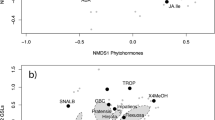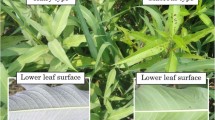Abstract
Natural populations of Datura wrightii in southern California are dimorphic for trichome type. Some plants within populations produce greater than 85% glandular trichomes, whereas other produce mainly nonglandular trichomes. Glandular trichome exudates in D. wrightii consist of glucose esterified with straight chain C6–C9 acids. These exudates, and similar exudates in other species, confer resistance to several insect herbivore species. We tested the hypothesis that water was limiting sugar ester production and examined the extent to which trichome density was determined by environmental factors by measuring the concentrations of sugar esters and the densities of trichomes on leaves of plants grown under different irrigation treatments. Water did not limit sugar ester production, as unwatered plants produced 36% more millimoles of glucose esters per square centimeter of leaf surface than did watered plants. Although the addition of water increased leaf size, densities of both nonglandular and glandular trichomes did not change with leaf length or area, suggesting that plants having larger leaves initiated more trichomes in order to maintain nearly constant densities. Millimoles of sugar esters produced did not correlate with densities of glandular trichomes, suggesting that other factors in addition to glandular trichome number govern the production of sugar esters for plant defense.
Similar content being viewed by others
REFERENCES
Agrawal, A. A. 1999. Induced responses to herbivory in wild radish: Effects on several herbivores and plant fitness. Ecology 80:1713–1723.
Ågren, J., and Schemske, D. W. 1992. Artificial selection on trichome number in Brassica rapa. Theor. Appl. Genet. 83:673–678.
Ågren, J., and Schemske, D. W. 1993. The cost of defense against herbivores: An experimental study of trichome production in Brassica rapa. Am. Nat. 141:338–350.
Ågren, J., and Schemske, D. W. 1994. Evolution of trichome number in a naturalized population of Brassica rapa. Am. Nat. 143:1–13.
Armstrong, W. P. 1986. The deadly Datura. Pac. Discovery 39:34–41.
Avery, A., Satina, S. and Rietsema, J. 1959. Blakeslee: The genus Datura. Ronald Press, New York.
Blauth, S. L., Churchill, G. A., and Mutschler, M. A. 1994. Identification of quantitative trait loci associated with acylsugar accumulation using intraspecific populations of the wild tomato, Lycopersicon penellii. Theor. Appl. Genet. 96:458–467.
Bonierbale, M. W., Plaisted, R. L., Pineda, O., and Tanksley, S. D. 1994. QTL analysis of trichome-mediated insect resistance in potato. Theor. Appl. Genet. 87:973–987.
Bryant, J. P., Chapin, F. S. III, and Klein, D. R. 1983. Carbon/nutrient balance of boreal plants in relation to vertebrate herbivory. Oikos 40:357–368.
Buta, J. G., Lusby, W. R., Neal, J. W., Waters, R. M., and Pittarelli, G. W. 1993. Sucrose esters from Nicotiana gossei active against the greenhouse whitefly Trialeuroides vaporariorum. Phytochemistry 32:859–864.
Chortyk, O. T., Pomonis, J. G., and Johnson, A. W. 1996. Synthesis and characterizations of insecticidal sucrose esters. J. Agric. Food Chem. 44:1551–1557.
Dimock, M. B., and Kennedy, G. G. 1983. The role of glandular trichomes in the resistance of Lycopersicon hirsutum f. glabratum to Heliothis zea. Entomol. Exp. Appl. 33:263–268.
Duffey, S. S. 1986. Plant glandular trichomes: Their partial role in defense against insects, pp. 151–172, in B. E. Juniper and T. R. E. Southwood (eds.). Insects and the Plant Surface. Edward Arnold, London.
Ehleringer, J. 1984. Ecology and ecophysiology of leaf pubescence in North American desert plants, pp. 113–132, in E. Rodrigues, P. L. Healey, and I. Mehta, (eds.). Biology and Chemistry of Plant Trichomes. Plenum Press, New York.
Eigenbrode, S. D., Trumble, J. T., and White, K. K. 1996. Trichome exudates and resistance to beet armyworm (Lepidoptera: Noctuidae) in Lycopersicon hirsutum f. typicum accessions. Environ. Entomol. 25:90–95.
Elle, E., and Hare, J. D. 2000. No benefit of glandular trichome production in natural populations of Datura wrightii? Oecologia 123:57–65.
Elle, E., Van dam, N. M., and Hare, J. D. 1999. Cost of glandular trichomes, a “resistance” character in Datura wrightii Regel (Solanaceae). Evolution 53:22–35.
Goffreda, J. C., Mutschler, M. A., Ave, D. A., Tingey, W. M., and Steffens, J. C. 1989. Aphid deterrence by glucose esters in glandular trichome exudate of the wild tomato, Lycopersicon pennelli. J. Chem. Ecol. 15:2135–2147.
Grant, V., and Grant, K. A. 1983. Behavior of hawkmoths on flowers of Datura meteloides. Bot. Gaz. 144:280–284.
Gregory, P., Ave, D. A., Bouthyette, P. Y., and Tingey, W. M. 1986. Insect-defensive chemistry of potato glandular trichomes, pp. 173–183, in B. E. Juniper and T. R. E. Southwood (eds.). Insects and the Plant Surface. Edward Arnold, London.
Heinrich, G. 1973. Die fienstruktur der trichom-hydathoden von Monarda fistulosa. Protoplasma 77:271–278.
Herms, D. A., and Mattson, W. J. 1992. The dilemma of plants: To grow or defend. Q. Rev. Biol. 67:283–355.
Hickman, J. C. 1993. The Jepson Manual. Higher Plants of California. University of California Press, Berkeley, California.
Johnson, H. B. 1975. Plant pubescence: An ecological perspective. Bot. Rev. 41:233–258.
Jones, C. G., Hare, J. D., and Compton, S. J. 1989. Measuring plant protein with the Bradford assay: 1. Evaluation and standard method. J. Chem. Ecol. 15:979–992.
Juvik, J. A., Shapiro, J. A., Young, T. E., and Mutschler, M. A. 1994. Acylglucoses from wild tomatoes alter behaviour and reduce growth and survival of Helicoverpa zea and Spodoptera exigua (Lepidoptera: Noctuidae). J. Econ. Entomol. 87:482–492.
Kennedy, G. G., and Yamamoto, R. T. 1979. A toxic factor causing resistance in a wild tomato to the tobacco hornworm and some other insects. Entomol. Exp. Appl. 26:121–126.
Kennedy, G. G., Yamamoto, R. T., Dimock, M. B., Williams, W. G., and Bordner, J. 1981. Effects of day length and light intensity on 2-tridecanone levels and resistance in Lycopersicon hirsutum f. glabratum to Manduca sexta. J. Chem. Ecol. 7:707–716.
Lauter, D. J., and Munns, D. N. 1986. Water loss in the glandular trichomes of chickpea (Cicer arietinum L.). J. Exp. Bot. 37:640–649.
Lemke, C. A., and Mutschler, M. A. 1984. Inheritance of glandular trichomes in crosses between Lycopersicon esculentum and Lycopersicon pennellii. J. Am. Hortic. Sci. 109:592–596.
Liedl, B. E., Lawson, D. M., White, K. K., Shaprio, J. A., Cohen, D. E., Carson, W. A., Trumble, J. T., and Mutschler, M. A. 1995. Acylsugars of wild tomato Lycopersicon pennellii alters settling and reduces oviposition of Bemisia argentifolii (Homoptera: Alerodidae). J. Econ. Entomol. 88:742–748.
Liu, T., Stansly, P. A., and Chortyk, O. T. 1996. Insecticidal activity of natural and synthetic sugar esters against Bemisia argentifolii (Homoptera: Aleyrodidae). J. Econ. Entomol. 89:1233–1239.
Luckwill, L. C. 1943. The Genus Lycopersicon, an Historical, Biological, and Taxonomic Survey of the Wild and Cultivated Tomatoes. The University Press, Aberdeen, U.K.
Mahlberg, P. G., Hammond, C. T., Turner, J. C., and Hemphill, J. K. 1984. Structure, development, and composition of glandular trichomes of Cannabis sativa, pp. 23–51, in E. Rodriguez, P. L. Healey, and I. Mehta (eds.). Biology and Chemistry of Plant Trichomes. Plenum, New York.
Mauricio, R. 1998. Costs of resistance to natural enemies in field populations of the annual plant Arabidopsis thaliana. Am. Nat. 151:20–28.
Munz, P. A. 1973. A California Flora (with Supplement). University of California Press, Berkeley, California.
Neal, J. W., Tingey, W. M., and Steffens, J. C. 1990. Sucrose esters of carboxylic acids in glandular trichomes of Solanum berthaultii deter settling and probing by green peach aphid. J. Chem. Ecol. 16:487–497.
Neal, J. W., Buta, J. G., Pittarelli, G. W., Lusby, W. R., and Bentz, J. A. 1994. Novel sucrose esters from Nicotiana gossei: Effective biorationals against selected horticultural insect pests. J. Econ. Entomol. 87:1600–1607.
Raffauf, R. A. 1970. A Handbook of Alkaloids and Alkaloid-Containing Plants. Smith Kline and French Laboratories, Philadelphia.
Roy, B. A., Stanton, M. L., and Eppley, S. M. 1999. Effects of environmental stress on leaf hair density and consequences for selection. J. Evol. Biol. 12:1089–1103. SAS. 1988. SAS /STAT User's Guide. Release 6.03. SAS Institute, Cary, North Carolina.
Severson, R. F., Chortyk, O. T., Stephenson, M. G., Akey, D. H., Neal, J. W., Pittarelli, G. W., Jackson, M. D., and Sisson, V. A. 1994. Characterization of natural pesticide from Nicotiana gossei, pp. 108–121, in P. A. Hedin, (ed.). Bioregulators for Crop Protection and Pest Control. American Chemical Society, Washington, D.C.
Thurston, R. 1970. Toxicity of trichome exudates of Nicotiana and Petunia species to tobacco hornworm larvae. J. Econ. Entomol. 63:272–274.
Tingey, W. M. 1981. The environmental control of insects using plant resistance, pp. 175–197, in D. Pimentel (ed.). CRC Handbook of Pest Management in Agriculture, Vol. 1. CRC Press, Boca Raton, Florida.
van dam, N. M., and Hare, J. D. 1998a. Differences in distribution and performance of two sapsucking herbivores on glandular and nonglandular Datura wrightii. Ecol. Entomol. 23:22–32.
van dam, N. M., and Hare, J. D. 1998b. Biological activity of Datura wrightii glandular trichome exudate against Manduca sexta larvae. J. Chem. Ecol. 24:1529–1549.
van dam, N. M., Hare, J. D., and Elle, E. 1999. Inheritance and distribution of trichome phenotypes in Datura wrightii. J. Hered. 90:220–227.
Wilkens, R. T., Shea, G. O., Halbreich, S., and Stamp, N. E. 1996. Resource availability and the trichome defense of tomato plants. Oecologia 106:181–191.
Yencho, G. C., Renwick, J. A. A., Steffens, J. C., and Tingey, W. M. 1994. Leaf surface extracts of Solanum berthaultii Hawkes deter Colorado potato beetle feeding. J. Chem. Ecol. 20:991–1007.
Author information
Authors and Affiliations
Rights and permissions
About this article
Cite this article
Forkner, R.E., Hare, J.D. Genetic and Environmental Variation in Acyl Glucose Ester Production and Glandular and Nonglandular Trichome Densities in Datura wrightii. J Chem Ecol 26, 2801–2823 (2000). https://doi.org/10.1023/A:1026493927622
Issue Date:
DOI: https://doi.org/10.1023/A:1026493927622




